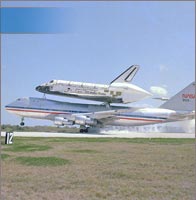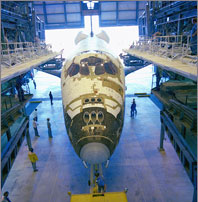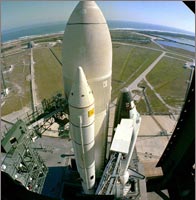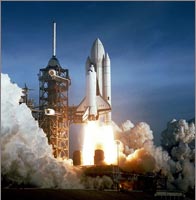Columbia Mission History
On April 12, 1981, Columbia roared into a deep blue sky as the nation’s first reusable Space Shuttle. Named after the first American ocean vessel to circle the globe and the command module for the Apollo 11 Moon landing, Columbia continued this heritage of intrepid exploration. The heaviest of NASA’s orbiters, Columbia weighed too much and lacked the necessary equipment to assist with assembly of the International Space Station. Despite its limitations, the orbiter’s legacy is one of groundbreaking scientific research and notable “firsts” in space flight.
Space Shuttle mission STS-9, launched in late November 1983, was the maiden flight for Spacelab. Designed to be a space-based science lab, Spacelab was installed inside the orbiter’s cargo bay. Spacelab featured an enclosed crew work module connected to an outside payload pallet, which could be mounted with various instruments and experiments. From inside the lab, astronauts worked with the experiments on the pallet and within the crew module itself. The lab would go on to fly aboard the rest of the fleet, playing host throughout its accomplished lifetime to unprecedented research in astronomy, biology and other sciences. Spacelab ultimately finished where its career began; its 16th and final mission was hoisted into space aboard Columbia in 1998.
In addition to Columbia’s STS-1 flight and Spacelab, the orbiter was also the stage for many other remarkable firsts. Germany’s Dr. Ulf Merbold became the first European Space Agency astronaut when he flew aboard 1983’s STS-9. The Japanese Space Agency and STS-65’s Chiaki Mukai entered history as the first Japanese woman to fly in space in 1994. In a display of national pride, the crew of STS-73 even “threw” the ceremonial first pitch for game five of the 1995 baseball World Series, marking the first time the pitcher was not only outside of the stadium, but out of this world.
Perhaps Columbia’s crowning achievement was the deployment of the gleaming Chandra X-ray Observatory in July 1999. Carried into space inside the orbiter’s payload bay, the slender and elegant Chandra telescope was released on July 23. Still in flight today, the X-ray telescope specializes in viewing deep space objects and finding the answers to astronomy’s most fundamental questions.
+ A website listing all of Columbia’s launches with dates and information
STS-107 Reference Information
+ Space Shuttle Overview: Columbia (OV-102)
A Letter From The Columbia Crew Families (03-04-03)
The Columbia crew families express gratitude for overwhelming public support. Charitable funds are now available for contributions.
+ Read More
NASA Administrator’s Testimony before House Committee on Science
Statement on the President’s FY 2004 budget proposal of $15.47 billion for NASA which demonstrates the Administration’s continued confidence in NASA’s ability to advance the Nation’s science and technology agenda. (02-27-03)
+ Read More
Mission Evaluation Room Reports (02-04-03)
Daily reports from the mission support team that tracks anomalies and their resolution.
+ View Acrobat PDF (141 Kb)
STS-107 Press Kit (02-02-03)
An overview of the mission, including crew biographies and descriptions of the experiments.
+ View Acrobat PDF (141 Kb)
NASA: Remembering Columbia
+ View
Early Space Shuttle History
+ View
STS-1 First flight of Columbia
+ View



